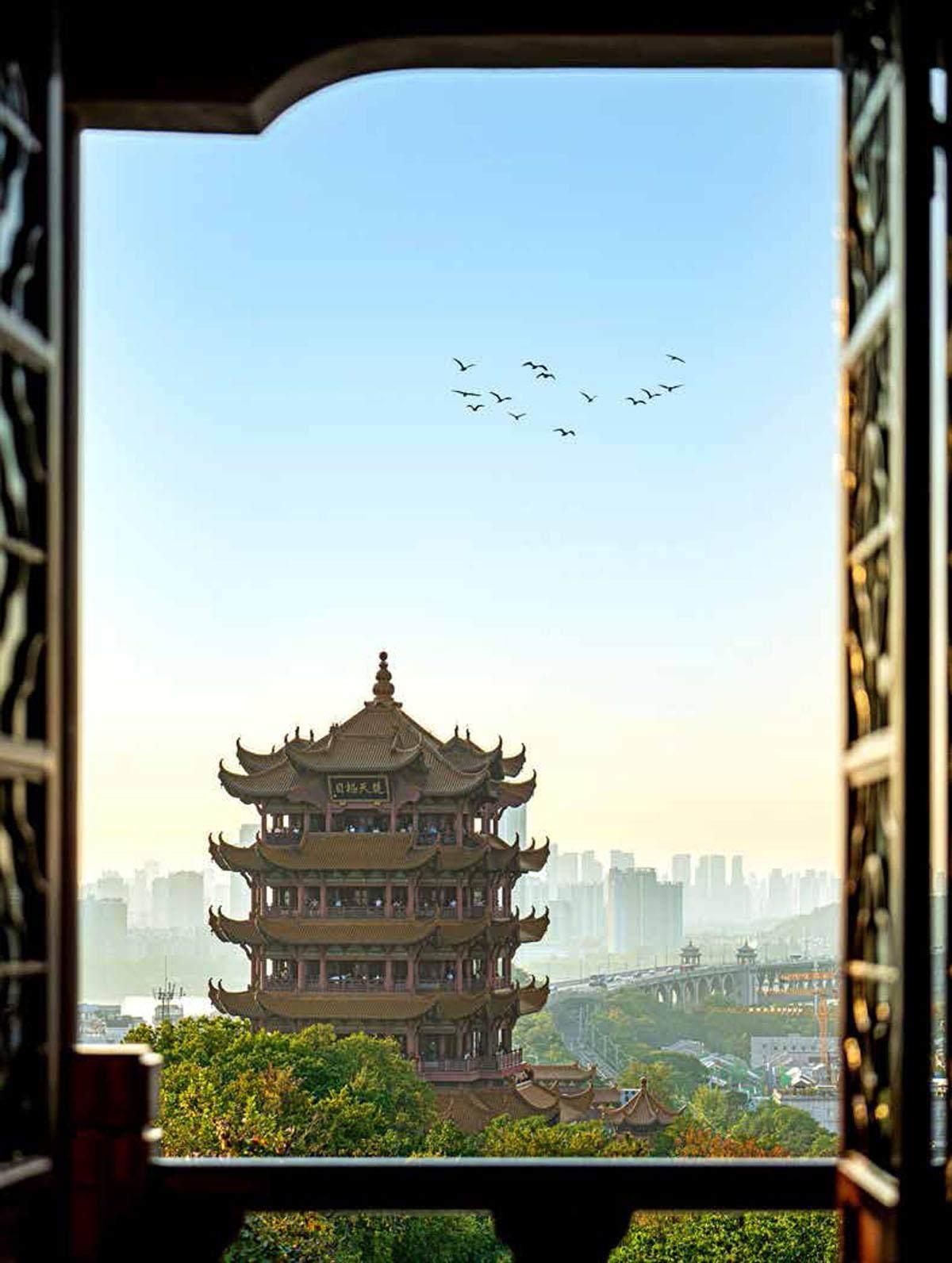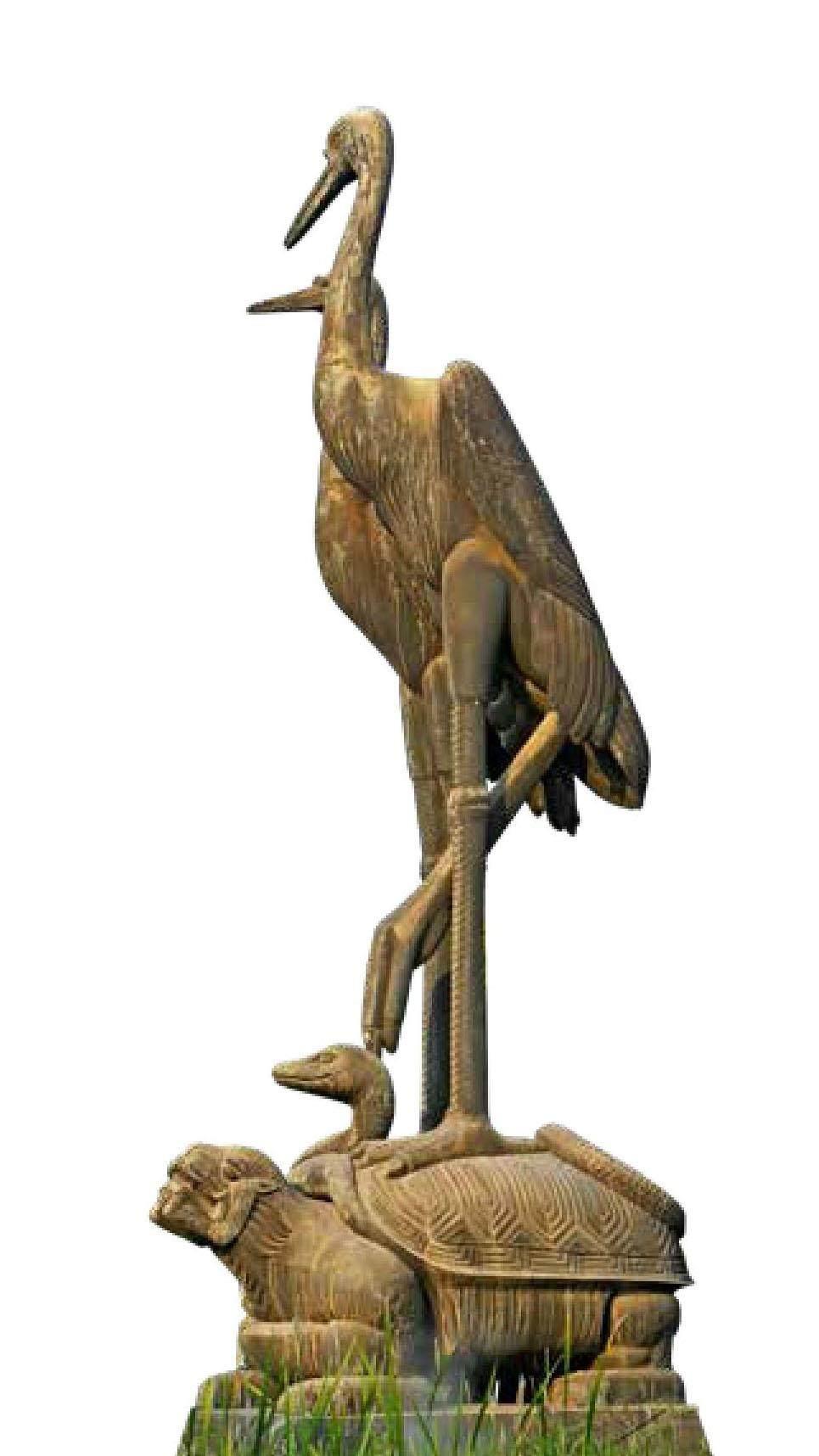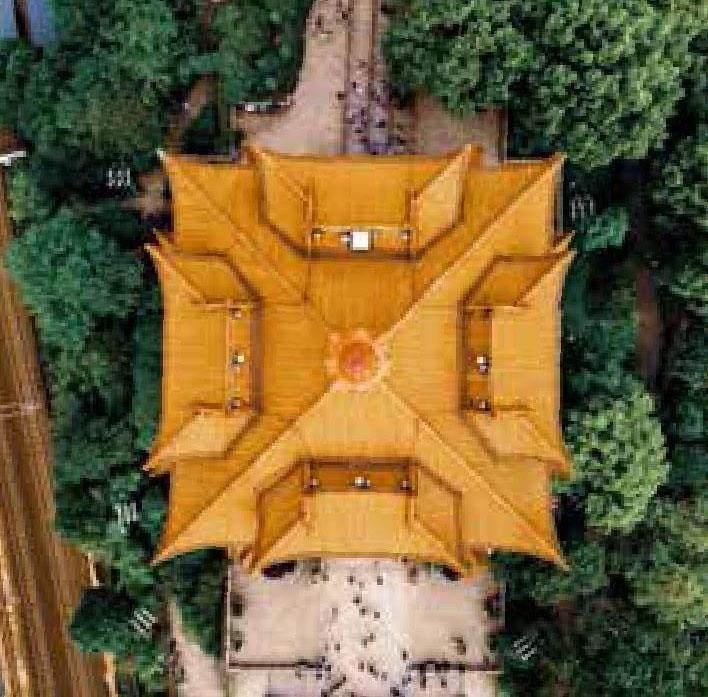天下江山第一楼
刘中兴Liu Zhongxing



在秀山起伏、湖波荡漾的美丽江城武汉,有一座如诗如画的千年古楼,她就是高居蛇山之巅的黄鹤楼。千百年来,白云环绕其上,万里长江从她的脚下东流而去。黄鹤楼阅千载白云,看一江奔流,享有“天下绝景”的盛誉,被称为“天下江山第一楼”。黄鹤楼与岳阳楼、滕王阁并称“江南三大名楼”。
In the enchanting city of Wuhan, a city renowned for its rolling hills andserene lakes, there stands a picturesque ancient tower that has graced thelandscape for thousands of years. This magnificent structure is the Yellow CraneTower, which majestically perching atop Snake Hill. Over the course of centuries,it has been encompassed by ethereal white clouds, while at its base the mightyYangtze River gracefully meanders eastward. The Yellow Crane Tower boaststhe esteemed title of the “Paramount Tower that Commands Mountains andRivers” and is revered alongside Yueyang Tower and the Pavilion of Prince Tengas the “Three Famous Towers of the South,” signifying the apex of architecturalbrilliance.
相传在中国古代,有一位姓辛的妇人在武汉的蛇山上开了一家酒楼。有一天,一位衣衫褴褛的老道蹒跚而来,向她讨酒喝。辛氏忠厚善良,任由老道免费喝了一年的酒。老道为表达谢意,捡起桌上的橘子皮,随手在墙上画了一只栩栩如生的黄鹤,并说:“ 以后有客人来喝酒,你拍手相招,这只黄鹤便会一跃而下,只要按音律拍手,它就会跳舞。”说完便消失不见了。辛氏将信将疑,双手一拍,黄鹤果然一跃而下,和着音律翩翩起舞,酒家因此生意兴隆。
Legend has it that, a long long time ago, there was a woman named Xinwho opened a restaurant on Snake Hill. One day, an old Taoist monk wholooked worn-out stumbled upon her establishment and asked for somewine. Xin, being a kind-hearted woman, allowed him to drink for free foran entire year. To express his gratitude, the old Taoist monk casually pickedup a tangerine peel from the table and drew a lifelike yellow crane on thewall. He said, “Whenever guests come for a drink, just clap your hands andthis yellow crane will leap down, and if you follow the rhythm, it will danceaccordingly.” After saying this, the old Taoist monk disappeared. Xin wasskeptical but decided to give it try. She clapped her hands, and to her surprise,the yellow crane leaped down from the wall and danced gracefully in sync withthe rhythm. Soon, her restaurant flourished.
十年后,老道忽然再次出现,问辛氏:“ 这十年来,黄鹤赚的钱够不够还当年欠下的酒债呢?”辛氏忙回道:“ 够!够!”于是,老道取下隨身携带的铁笛,对着墙上的黄鹤吹了一首奇妙的曲子,黄鹤闻声而下,起舞一番后,便驮着老道飞走了。辛氏为表感恩,在蛇山上修了一座楼阁纪念这位老道,并取名“黄鹤楼”。
Ten years later, the old Taoist monk suddenly reappeared and asked Xin,“Have the earnings from the yellow crane been enough to repay my winedebt from all those years ago?” Xin quickly replied, “Yes, more thanenough!” Upon hearing that, the old Taoist monk took out a flutethat he always carried with and played a beautiful tune towards theyellow crane on the wall. The yellow crane descended, danced fora while, and then carried the old Taoist monk away. To showher gratitude, Xin built a tower on Snake Hill and named itthe Yellow Crane Tower.
但在歷史上,黄鹤楼的出现并非如此浪漫。三国时期东吴黄武二年(公元223年),出于军事目的,孙权在蛇山建楼作为军事瞭望所。晋灭东吴以后,三国归于一统,该楼就失去了军事价值,到了唐朝已成为一处名胜古迹。之后几经战火,黄鹤楼屡废屡建,最后一次被毁是在清光绪十年(公元1884年),此后近百年未曾重修。
However, the actual historical originof the Yellow Crane Tower is not asromantic as the legend suggests. Duringthe Three Kingdoms Period in the secondyear (223 AD) of the Huangwus reign, SunQuan, founder of Eastern Wu Kingdom,decided to build a tower on Snake Hill formilitary purposes. After the Jin Dynastyconquered Eastern Wu and unified thethree kingdoms, the tower lost its militarysignificance and became known as ahistorical site during the Tang Dynasty.Throughout the years, the Yellow CraneTower was destroyed and rebuilt multipletimes. After its destruction in the 10thyear (1884 AD) of the Guangxus reign, the tower remainedunrepaired for nearly a century.
1981年10月,黄鹤楼重修工程动工;1985年6月落成。新楼采用现代建筑技术施工,钢筋混凝土框架仿木结构。黄鹤楼外观五层,内部实际有九层,隐含“九五至尊”之意。飞檐五层,攒尖楼顶,金色琉璃瓦屋面;通高51.4米,底层边宽30米,顶层边宽18米;72根圆柱拔地而起,雄浑稳健;60个翘角凌空舒展,恰似黄鹤腾飞;楼的屋面用10 万多块黄色琉璃瓦覆盖,辉煌壮丽。
In October 1981, the reconstruction of the Yellow CraneTower commenced and was completed in June 1985. The newtower was constructed using modern architectural techniques,featuring a reinforced concrete frame that imitates woodenstructures. Externally, the Yellow Crane Tower consists of fivefloors, while internally it boasts nine, symbolizing its esteemedstatus.1 It features upturned eaves, a pointed roof, and goldenglazed tiles. Standing at a height of 51.4 meters, it has a basewidth of 30 meters and a top width of 18 meters. The tower issupported by 72 pillars, all strong and stable, and 60 upturnedcorners that resemble majestic yellow cranes in flight. The roofis adorned with over 100,000 yellow glazed tiles, presenting amagnificent and splendid spectacle.
登楼远眺,“极目楚天舒”,“不尽长江滚滚来”,一座座长江大桥就像一道道彩虹连接两岸,江面上货轮、客轮穿梭往来。三镇沿江处,一幢幢高楼拔地而起,夜晚灯火辉映,流光溢彩,触目皆风景,四季各不同。
From the pinnacle of the tower, one can relish the panoramic view of the Chu region (now commonlyknown as Hunan Province), a view once impressed Chinese celebrities from the Tang poet Du Fu, who wrote“The boundless forest sheds its leaves shower by shower./The endless river rolls its waves hour by hour” in hispoem “On the Height,”1 to the former PRC Chairman Mao Zedong, who wrote “And as far as can reach theeye,/I find the wide, wide Southern sky” in his “Swimming” to the classical Chinese tune called “Prelude tothe Melody of Water.”2 The bridges spanning the Yangtze River resemble kaleidoscopic rainbows connectingthe two banks. Underneath the bridges are the traversing cargo and passenger ships. Along the riverbanks,towering buildings illuminate the night sky with their resplendent lights, creating awe-inspiring scenery thattransforms with each season.
黃鹤楼是古典与现代融合、诗与美构筑的精品。她处在山川灵气的交汇点,正好迎合中华民族喜好登高的民风民俗、亲近自然的空间意识和崇尚宇宙的哲学观念。除了地利之便与建筑之美,黄鹤楼更因其丰富的人文意蕴和审美价值而闻名于世。历代文人墨客只要到武汉,必登黄鹤楼,并留下大量绝妙的诗文。其中,唐代诗人崔颢的诗作《黄鹤楼》流传最广,被誉为“唐人七律的压卷之作”:“ 昔人已乘黄鹤去,此地空余黄鹤楼。黄鹤一去不复返,白云千载空悠悠。”相传,李白登上黄鹤楼后,看江水一色浩浩汤汤,顿时诗兴大发,正准备题诗之时,却看到了崔颢的《黄鹤楼》。斟词酌句推敲下来,李白忍不住拍案叫绝,他觉得这首诗写得实在太好了,将自己想要表达的情感都说完了,忍不住又懊恼又惆怅:“ 一拳捣碎黄鹤楼,一脚踢翻鹦鹉洲。眼前有景道不得,崔颢题诗在上头。”最后,他只能无奈搁笔离去。自那以后,他又数次登上黄鹤楼,终于留下千古绝句《黄鹤楼送孟浩然之广陵》:“ 故人西辞黄鹤楼,烟花三月下扬州。孤帆远影碧空尽,唯见长江天际流。”还有《与史郎中钦听黄鹤楼上吹笛》:“ 一为迁客去长沙,西望长安不见家。黄鹤楼中吹玉笛,江城五月落梅花。”这也是武汉被称为“江城”的来历。
The Yellow Crane Tower is a masterpiece that combines classical and modern elements, having its uniquepoetic and architectural charms. It is situated at an area where mountains meet rivers, a place frequented bythe Chinese people who have a tradition of mountain climbing, a fondness for nature, and a philosophicalawareness of the work of the universe. Apart from its advantageous location and architectural beauty, theYellow Crane Tower is renowned for its rich cultural and aesthetic value. Throughout history, literati and poetswho climbed the Yellow Crane Tower when visiting Wuhan left behind a treasure trove of exquisite poemsand writings about this architectural wonder. Among them, the poem “Yellow Crane Tower” by the Tang poetCui Hao is the most widely circulated and acclaimed, a masterpiece of seven-character Tang poetry:
Yellow Crane Tower Cui Hao
The sage on yellow crane was gone amid clouds white.
To what avail is Yellow Crane Tower left here?
Once gone, the yellow crane will never on earth alight;Only white clouds still float in vain from year to year.1
Legend has it that the most celebrated Tang poet Li Bai, who ascended the tower and became bursting with poetic fervor at the sight of the vast expanse of the Yangtze River, could not help marveling when he read Cuis poem, to which he responded:
Ascending the Yellow Crane Tower with Friends and Seeing Cui Haos Inscribed Poem
Li Bai
In one blow, I smash the Yellow Crane Tower,With one kick, I overturn Parrot Island.
Before my eyes, a breathtaking view unfolds,Yet words fail to capture what my heart beholds.
Above, Cui Haos poem, elegantly inscribed,Resides, as if in glory, on this towers stride.2
Li felt that Cuis poem was incredibly wellwrittenand that it had already expressed all theemotions he himself wanted to convey. Feelingregretful and melancholic, Li put down his brush andleft. Since then, he climbed the Yellow Crane Towerseveral times and finally left behind the followingtimeless quatrains:
Seeing Meng Haoran off at Yellow Crane TowerLi Bai
My friend has left the west where the Yellow Crane TowerFor River Town veiled in green willows and red flowers.His lessening sail is lost in the boundless blue sky,Where I see but the endless River rolling by.3
On Hearing the Flute in Yellow Crane Tower
Li Bai
Since I was banished to the riverside town,Looking westwards, Ive found no house Id call my town.Hearing in Yellow Crane Tower the flutes sad tune,I seem to see mume blossoms fall in the fifth moon.4
The last poem also explains the origin of Wuhan being called the “Riverside Town.”
公元1134年,宋代抗金名将岳飞驻守鄂州(今武昌)。他登上黄鹤楼,想到南方寇患虽平,但中原大地仍在敌人铁骑蹂躏之下,心潮起伏间挥笔写下《满江红 ·登黄鹤楼有感》。公元1136年,岳飞再次登上黄鹤楼,坚定北伐收复中原之志,写下《满江红 · 怒发冲冠凭栏处》,慷慨激昂,直抒胸臆,其深沉的爱国情感,至今仍震撼人心。时至今日,武昌黄鹤楼的岳飞广场东侧立有一尊岳飞铜像,栩栩如生地刻画了他扶鞍勒马、不忍举首北望破碎山河的悲愤神态,一旁还矗立一方岳飞手迹“还我河山”石刻,铜像背后,一块长达25.6米的青石浮雕再现了当年岳家军驰骋沙场、英勇杀敌的场景。
In the 11th century, the renowned Song Dynastygeneral Yue Fei was stationed in Ezhou (now the cityof Wuchang). He ascended the Yellow Crane Towerand wrote “On Mounting Yellow Crane Tower”5 to thetune of “The River All Red” with the inspiration thatalthough the northern enemies had been subdued,the Central Plains were still under their control. In1136, Yue Fei climbed the Yellow Crane Tower onceagain, determined to launch a Northern Expeditionand reclaim the Central Plains. He wrote “Wraths setson end my hair, I lean on railings”6 to the same tune,which expressed his indignation and patriotism. Hispoems continue to resonate with people today. Today,there is a bronze statue of Yue Fei on the east side of the Yue Fei Palaza of the Yellow Crane Tower Park vividlydepicting his sorrowful expression as he holds the reins of his horse and looks all solemn northward. Next tothe statue is a stone carving of Yue Feis handwriting saying “Restore My Rivers and Mountains.” Behind thebronze statue, a 25.6-meter-long relief made of green stone reproduces the scenes of the Yues Army chargingon the battlefield and bravely fighting their enemy.
此外,陸游、苏轼等诗词名家也曾吟咏黄鹤楼。1927 年2月,一代伟人毛泽东登上黄鹤楼,满腔热血,激情澎湃,执着地探寻中国的前进道路,写下名篇《菩萨蛮 · 黄鹤楼》:“ 茫茫九派流中国,沉沉一线穿南北。烟雨莽苍苍,龟蛇锁大江。黄鹤知何去?剩有游人处。把酒酹滔滔,心潮逐浪高。”
Not only Yue Fei, but also renowned poets like Lu You and Su Shihave composed poems about the Yellow Crane Tower. In February1927, the former PRC Chairman Mao Zedong, who was then exploringthe path of Chinas progress, climbed the tower, fueled with passionand determination. He wrote the famous poem “Yellow Crane Tower”to the tune of “Buddhist Dancers”:
Yellow Crane Tower
Mao Zedong
Wide, wide through the land flow nine streams full to the brim;
Long, long from south to north threads one line deep and dim.
Shrouded in grizzling mist and drizzling rain.
Tortoise and snake hold the River in chain.
Where is the yellow crane in flight,
Leaving for visitors a site?
I pledge with wine the endless flood;
With rolling waves upsurges my blood.1
在這些千古名篇的加持下,黄鹤楼名声大振。今天,再登黄鹤楼,吟诵这些诗词,仔细感受时间与空间、长天与大江、人文与地理、历史与现实的交融,一定能体会到铭刻在黄鹤楼记忆之中的诗词之美。
The name of the Yellow Crane Tower travelled with these timelesspoems. When you ascend the tower today and recite these poems, youcan deeply sense the fusion of time and space, the convergence of skyand river, the integration of culture and geography, and the interweavingof history and reality. Undoubtedly, you will be able to experience thebeautiful memories of the Yellow Crane Tower infused into these verses.
因武而建,以文而兴,黄鹤楼所蕴含的文化、历史和艺术价值,让她成为一个独特的文化地标。这种能够超越时间和空间的持续生命力,让人们更加感受到黄鹤楼的不朽魅力。
The Yellow Crane Tower, a stronghold fortified by the alchemyof literature, breathes the essence of culture, history, and artistry, andhas become a unique cultural landmark. Its timeless vitality will defytemporal and physical boundaries, and continue inviting seekers torevel in its immortal charisma.
- 孔子学院的其它文章
- 曾侯乙编钟The Chime Bells in the Tomb of the Marquis Yi
- 洪湖凤舟Honghu Phoenix Boats
- 守护神农架The Conservation of Shennongjia
- 国际中文教师教育专家谈International Education Experts’Discussion on How to Improve International Chinese Language Teachers’ Education and Training
- 二十四节气之白露和秋分The 24 Solar Terms
- 武汉,每天都不一样A Hundred Faces of Wuhan

